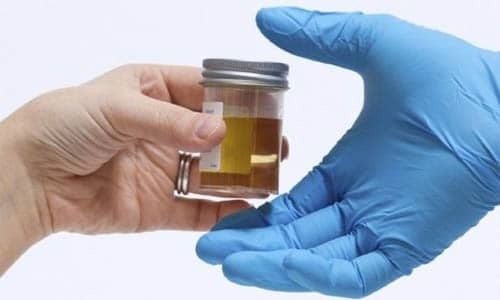Red blood cells are called red blood cells. If they appear in the urine, then a similar phenomenon is called hematuria. Erythrocytes in the urine are a disturbing manifestation, which indicates the development of serious pathologies of the genitourinary system or kidneys. Urine can tell a lot about the patient and the condition of his organs. That is why diagnostic procedures for any disease include urine testing. The fact that red blood cells are present in the blood often speaks of its reddish hue. In the norm of red blood cells in the composition of urine should not be.

Sometimes erythrocytes penetrate into the urine with increased physical overload. This phenomenon is explained by the increase in pressure, which leads to increased renal blood flow and impaired glomerular activity, as a result of which blood is discharged in small quantities into urine.
Common causes of ingestion of blood cells in urine
Usually erythrocytes in urine are detected due to bleeding localized in the kidneys, bladder, ureter or urethra. Among the most common causes of the emergence of blood in the urine, there are several factors.
- Traumatic injury. If an injury has occurred in the inguinal region, resulting in damage to the blood vessels or soft tissue structures, the red cells can penetrate the urine. Especially often this phenomenon occurs with traumatic injuries of the bladder or kidney tissues.
- Tumor processes. Regardless of the degree of malignancy, any neoplasm localized in the kidney or other genitourinary organs can contribute to the appearance of blood in the urine. In a similar situation, red blood cells penetrate into urine due to tumor growth, leading to damage to the vasculature or deformative cell changes. The urinary and renal concretions are also capable of provoking hematuria. Stones, when passed through the urinary tract, violate the integrity of their walls, which causes bleeding.
- Infectious processes in the genito-urinary organs. This factor is explained by the fact that during the development of infection, a large amount of toxic substances that damage mucous tissues is produced. In addition, the infection is accompanied by a violent activity of microorganisms that feed on cells of internal organs. As a result, inflammatory processes develop, the walls of the organs and the vessels are damaged, which leads to bleeding. Sometimes erythrocytes leak into urine under the influence of tuberculous or purulent processes such as cystitis, urethritis, etc.
This is far from all factors contributing to the penetration into the urine of red blood cells. There are many diseases, often accompanied by a similar symptomatology. Such pathologies include vascular disorders due to thrombosis or the formation of blood clots in the renal vascular system. In addition, other kidney pathologies such as glomerulonephritis, pyelonephritis, or necrosis of papillary nature may lead to the appearance of hematuric symptoms.
Pathologies caused by disorders of the hematopoiesis system such as hemophilia, sickle cell anemia, leukemia. In addition, the erythrocytes in the urine can result in medications prescribed to reduce blood loss or dilution of blood. Also, the blood in urine can appear as a result of benign cystic formations in the tissues of the kidneys.
If such a deviation occurred against the background of pyelonephritis, the blood appears in the urine not immediately, but when the pathology develops to 2-3 stages. With glomerulonephritis urine is distinguished by a brownish tint, because the blood is released into it in small amounts. In the presence of diabetes mellitus, papillary necrosis often develops - it is a pathological condition characterized by the destruction of finely capillary structures against the background of oxygenation and excessive sugar content in the blood. Against the background of papillary necrosis, erythrocytes penetrate into the urine not constantly, but periodically.
Diagnostic Methods
 It is not always possible to detect erythrocytes in urine without an appropriate laboratory test, because the color of urine changes only in the case of abundant bleeding. If there is not enough blood, urine becomes a little brownish. If the erythrocytes appear in the urine in the form of coagulated blood lumps, which also remain on the laundry, this may indicate the presence of a tumor process in the urinary system or the kidney tissues.
It is not always possible to detect erythrocytes in urine without an appropriate laboratory test, because the color of urine changes only in the case of abundant bleeding. If there is not enough blood, urine becomes a little brownish. If the erythrocytes appear in the urine in the form of coagulated blood lumps, which also remain on the laundry, this may indicate the presence of a tumor process in the urinary system or the kidney tissues.
If the color of urine is red or red, this may indicate renal bleeding or urogenital dysfunction. If, along with erythrocytes, problems with urination appear, such as burning, soreness or difficulty, then hematuria is most likely caused by urolithiasis or infectious processes in the kidneys.
If erythrocytes appear in urine due to prostatic pathologies or kidney infection, the man is often concerned about the urge to urinate, even when the bladder is empty.
To determine a specific diagnosis, it is necessary to conduct a number of additional studies such as a blood test, ultrasound diagnosis, cytoscopic research, etc. Only a comprehensive examination will give a complete picture of the condition and allow a reliable diagnosis.
Treatment approach
Treatment is appointed by the urologist or nephrologist in accordance with the cause of the formation of erythrocyte cells in urine. The main therapeutic direction is the elimination of the primary cause, the symptom of which is the blood in the urine.
If the causes are covered in bleeding, the patient is assigned haemostatic agents. In the presence of concrements shows the intake of antispasmodics and the therapy necessary to improve the yield of stones. Also, treatment can be supplemented with antibiotic, hormonal and other drugs, and in extreme cases resort to surgical intervention.



